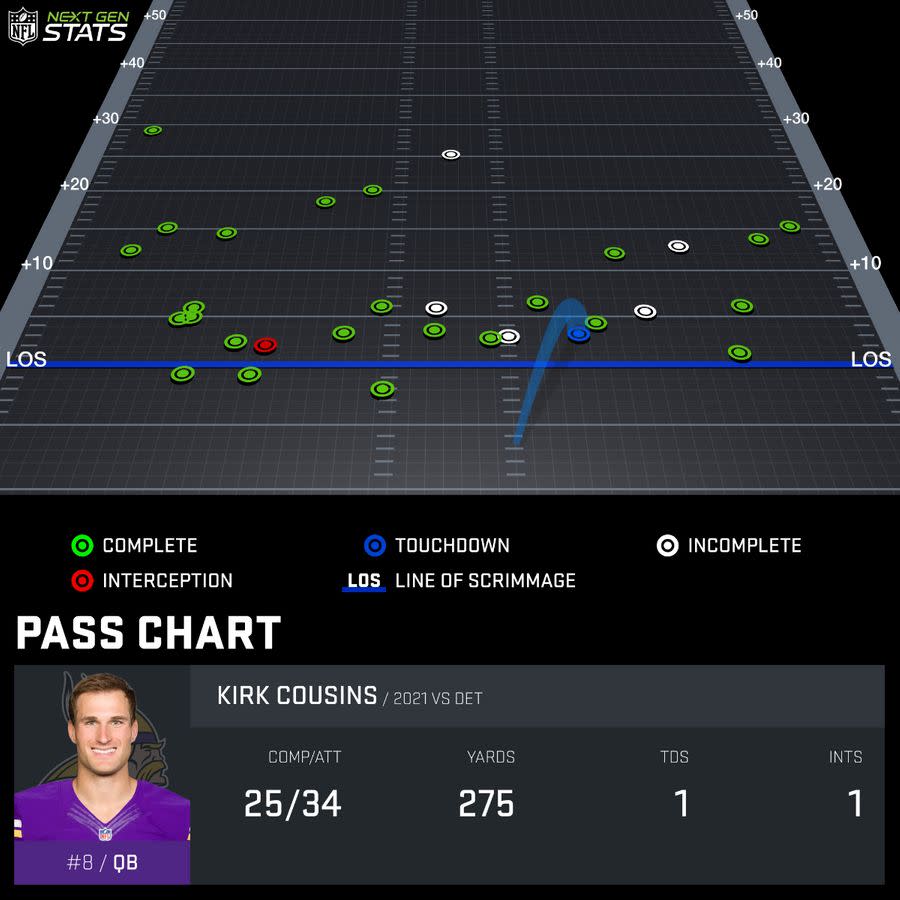Jared Goff’s passing chart shows where the Lions offense is limited

The great debate about Jared Goff continues in Detroit. The Lions quarterback has generally given both his advocates and critics ample ammunition in each of the first four games of the 2021 season. In Week 5, it’s going to be hard for the Goff supporters to find a viable leg to stand on.
Goff completed 21 of his 35 pass attempts in the loss to the Minnesota Vikings. The 35 attempts netted just 203 passing yards, an unacceptably low number. A look at Goff’s passing chart from NFL Next Gen Stats illustrates where the Lions offense struggles with Goff and his receivers.
They simply do not have any success down the field. Nor do they really even try:

There are seven attempts to receivers behind the line of scrimmage. Over half of Goff’s passes were to targets five yards or less from the line. Just five attempts traveled more than 15 yards down the field, and none of those were completed.
Goff isn’t alone out there, of course. Coordinator Anthony Lynn tailors some of the passing scheme to Goff’s preferences to hit the sure, short shots instead of the riskier attempts down the field. Detroit’s receiving corps isn’t one that strikes fear into opposing defenses, though Quintez Cephus and Amon-Ra St. Brown have both developed nicely through the first few weeks. The team’s vertical threat is Kalif Raymond, all 5-foot-8 and 182 (soaking wet) pounds of him.
Lynn’s scheme and Goff’s style necessitate receivers gaining yards after the catch. And against the Vikings, Detroit did well in the YAC department. The Lions gained 145 yards after the catch per Pro Football Focus, nearly double the Vikings’ total of 75. But therein lies the problem.
Minnesota can hit the big gains, the chunk yardage plays, with throws down the field. Kirk Cousins has his faults as a quarterback, but the Vikings QB isn’t afraid to air it out. Cousins hit nine completions where the receiver was at least 10 yards down the field, to Goff’s two.

Again, the context of the receivers needs to be factored in. Cousins is throwing to Justin Jefferson and Adam Thielen, both of whom are much more talented than any wide receiver Goff has at his disposal. But the underlying philosophy and willingness to test defenses down the field also elevates Cousins and the Minnesota offense. They stress secondaries with downfield shots. Detroit’s offense invites safeties into the box, which inhibits the impressive running game.
It’s also a major problem on third downs. In this game, Goff attempted nine passes on third downs. Not a single one had enough air yards to attain the yards needed for the conversion:
3rd-and-9: Incomplete pass to KhaDarel Hodge, 2 yards from LOS
3rd-and-5: Complete to St. Brown for 13 yards, 0 air yards
3rd-and-6: Complete to Cephus for 4 yards, 4 air yards
3rd-and-8: Complete to Cephus for 21 yards, 6 air yards
3rd-and-10: Complete to St. Brown for 8 yards, minus-1 air yards
3rd-and-7: Incomplete to Trinity Benson, 3 air yards
3rd-and-5: Complete to D’Andre Swift for 2 yards, 0 air yards
3rd-and-6: Complete to St. Brown for 2 yards, minus-2 air yards
3rd-and-10: Incomplete throwaway on a screen, minus-1 air yards
Bottom line: if Goff doesn’t start throwing deeper and the Lions offense continues to rely on dink-and-dunk dumpoffs, it’s going to be increasingly difficult for Detroit to find success.
This was the same issue Goff had with the Los Angeles Rams, unfortunately. There are route options present for him to try farther down the field. No, those are not typically the best options. The white dot way down the field in Goff’s chart was a terrible decision to throw into double coverage to Raymond, who gave away at least three inches and 15 pounds to both Vikings defenders on the jump ball throw. But until the Lions offense opens up more, they’re too easy to defend.

